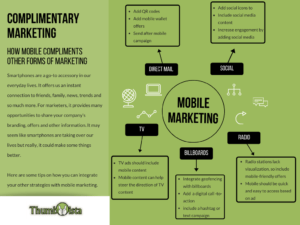Programmatic mobile advertising is a critical component of the modern marketing mix. In today’s digital age, where consumers are increasingly using mobile devices to access the internet and make purchases, mobile advertising is more important than ever. Programmatic digital advertising allows for more targeted and efficient ad delivery, making it a valuable tool for marketers looking to maximize their advertising ROI. Let’s take a closer look at why these two forms of advertising are so essential, along with some stats and examples to illustrate their effectiveness.
Why Mobile Advertising Matters
A mobile presence is critical because mobile usage is growing rapidly. According to a recent report by eMarketer, over 3.8 billion people worldwide will use a smartphone in 2021, with that number expected to grow to over 4.3 billion by 2023. Additionally, over 60% of all internet traffic now comes from mobile devices. These statistics demonstrate the importance of mobile advertising for marketers looking to reach their target audience where they spend the most time – on their smartphones.

Mobile advertising can take many forms, including display ads, in-app ads, and mobile video ads. One example of a successful mobile advertising campaign is Pepsi’s “Uncle Drew” campaign, which used mobile video ads to promote a series of videos featuring NBA player Kyrie Irving in old-age makeup playing street basketball. The campaign was a huge success, with the mobile video ads generating over 300 million views and driving over 2 million clicks.
Why Programmatic Advertising Matters
Programmatic digital advertising allows for more targeted and efficient ad delivery, making it a valuable tool for marketers looking to maximize their advertising ROI. Programmatic advertising uses algorithms and data to target specific audience segments, allowing advertisers to deliver ads that are more relevant and effective.
According to a recent report by eMarketer, programmatic advertising accounted for over 85% of all digital display ad spending in the US in 2020. Additionally, programmatic advertising is expected to grow to over $147 billion by 2021. These statistics demonstrate the effectiveness of programmatic advertising for marketers looking to reach their target audience more efficiently.
One example of a successful programmatic advertising campaign is Airbnb’s “Live There” campaign, which used programmatic advertising to target specific audience segments with relevant ads. The campaign resulted in a 20% increase in user engagement and a 20% increase in bookings.
Conclusion
In today’s digital age, mobile and programmatic digital advertising are essential components of the modern marketing mix. Mobile advertising allows marketers to reach their target audience where they spend the most time, while programmatic advertising allows for more targeted and efficient ad delivery. By incorporating mobile and programmatic digital advertising into their marketing strategies, marketers can maximize their advertising ROI and reach their target audience more effectively.

